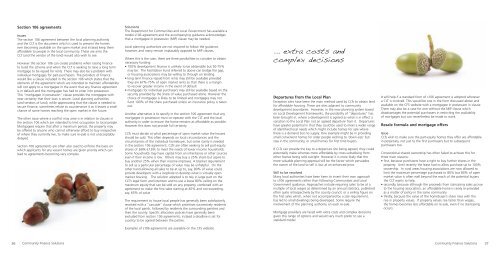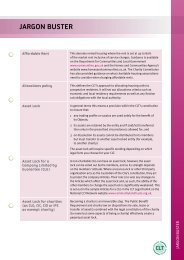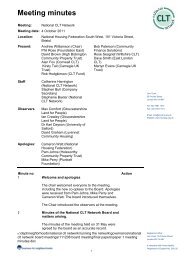Then we will do it ourselves - Community Land Trusts
Then we will do it ourselves - Community Land Trusts
Then we will do it ourselves - Community Land Trusts
Create successful ePaper yourself
Turn your PDF publications into a flip-book with our unique Google optimized e-Paper software.
Section 106 agreementsIssuesThe section 106 agreement bet<strong>we</strong>en the local planning author<strong>it</strong>yand the CLT is the <strong>do</strong>cument which is used to prevent the homesever becoming available on the open market and instead keep themaffordable to people in the local commun<strong>it</strong>y. These are aims theCLT (and the ven<strong>do</strong>r of the land) would also wish to see.Ho<strong>we</strong>ver the section 106 can create problems when raising financeto build the scheme and when the CLT is seeking to raise a long termmortgage to be repaid for rents. There may also be a problem w<strong>it</strong>hindividual mortgages for part-purchasers. The providers of financewould like a clause included in the section 106 which states that theelements of the agreement which are intended to maintain affordabil<strong>it</strong>y<strong>will</strong> not apply to a mortgagee in the event that any finance agreementis in default and the mortgagee has had to enter into possession.This “mortgagee in possession” clause provides the mortgagee w<strong>it</strong>hnear certainty that their loan is secure. Local planning author<strong>it</strong>ies(and ven<strong>do</strong>rs of land), while appreciating that the clause is needed tosecure finance, sometimes refuse to countenance <strong>it</strong> as <strong>it</strong> leaves a smallchance of some homes reaching the open market in the future.The other issue where a conflict may arise is in relation to clauses inthe section 106 which are intended to lim<strong>it</strong> occupation to local people.Mortgagees require that after a maximum period, the property maybe offered to anyone who cannot otherwise afford to buy irrespectiveof where they currently live, to make sure re-sale is not unacceptablydelayed.Section 106 agreements are often also used to enforce the basis onwhich applicants for any vacant homes are given prior<strong>it</strong>y which canlead to agreements becoming very complex.SolutionsThe Department for Commun<strong>it</strong>ies and Local Government has available amodel s106 agreement and the accompanying guidance acknowledgesthat a mortgagee in possession (MIP) clause may be needed.Local planning author<strong>it</strong>ies are not required to follow the guidance,ho<strong>we</strong>ver, and many remain implacably opposed to MIP clauses.Where this is the case, there are three possibil<strong>it</strong>ies to consider to obtainnecessary funding:• 100% development finance is unlikely to be obtainable but 50-75%may be. The Facil<strong>it</strong>ation Fund referred to above can bridge the gap;or housing associations may be <strong>will</strong>ing to through on lending.• long term finance repaid from rents may still be available providedthey are 67%-75% of open market rents so that there is a marginto recover greater income in the event of default• mortgages for individual purchasers may still be available based on thesecur<strong>it</strong>y provided by the share of value purchased alone. Ho<strong>we</strong>ver thechoice of mortgagee is likely to be lim<strong>it</strong>ed and mortgages may notfund 100% of the share purchased unless an insurance policy is takenout.Another alternative is to specify in the section 106 agreement that anymortgagee in possession must co-operate w<strong>it</strong>h the CLT and the localauthor<strong>it</strong>y in order to ensure the home remains as affordable as possible.Ho<strong>we</strong>ver this <strong>do</strong>es not provide full certainty.CLTs must decide at what percentage of open market value the housesshould be sold. This often depends on local circumstances and thecircumstances of the individual homebuyer, but some clar<strong>it</strong>y is neededin the section 106 agreement. CLTs are often seeking to sell part-equ<strong>it</strong>yshares of £60k-£120k to meet the needs of lo<strong>we</strong>r income households.Some households may have cap<strong>it</strong>al from an inher<strong>it</strong>ance or other sourceseven if their income is low. Others may buy a 25% share but aspire tobuy another 25% when their income improves. A blanket requirementto sell as a particular percentage of value may be unhelpful. On theother hand allowing all sales to be at up to, say, 80% of value couldprovide developers w<strong>it</strong>h a loophole to develop what is virtually openmarket housing. The solution a<strong>do</strong>pted is to rely in large part on theCLT’s legal form and intention and to use a loose 80% ceiling on themaximum equ<strong>it</strong>y that can be sold on any property, combined w<strong>it</strong>h anagreement to make the first sales starting at 40% and not exceeding,say, 65% of value.The requirement to house local people has generally been satisfactorilyresolved w<strong>it</strong>h a “cascade” clause which prior<strong>it</strong>ises successively residentsof the local parish, follo<strong>we</strong>d by residents the surrounding parishes andthen the county. Specific allocation policies have generally beenexcluded from section 106 agreements, instead a deadline is set fora policy to be agreed bet<strong>we</strong>en the parties.... extra costs andcomplex decisionsDepartures from the Local PlanException s<strong>it</strong>es have been the main method used by CLTs to obtain landfor affordable housing. These are s<strong>it</strong>es adjacent to commun<strong>it</strong>ydevelopment boundaries. Ho<strong>we</strong>ver, in the new planning system base<strong>do</strong>n Local Development Frameworks, the possibil<strong>it</strong>y of “departures” hasbeen brought in, where a development is agreed as what is in effect avariation to the Local Plan not an agreed departure from <strong>it</strong>. Departureshave greater potential in that they could be used to meet a wider rangeof identified local needs which might include homes for sale wherethere is a demand but no supply. One example might be in providingsmall convenient homes for older people wishing to ’<strong>do</strong>wn-size’ butstay in the commun<strong>it</strong>y, or small homes for first time buyers.If CLTs can provide the key to a departure s<strong>it</strong>e being agreed, they couldpotentially make schemes more affordable by cross-subsidising fromother homes being sold outright. Ho<strong>we</strong>ver <strong>it</strong> is more likely that themore valuable planning approval <strong>will</strong> be the factor which persuadesthe owner of the land to sell <strong>it</strong>, but at an enhanced price.Still to be resolvedMany local author<strong>it</strong>ies have been keen to invent their own approachto s106 agreements rather than following Commun<strong>it</strong>ies and LocalGovernment guidance. Approaches include requiring sales to be at amultiple of local wages as determined by an annual statistics, publishe<strong>do</strong>ften qu<strong>it</strong>e retrospectively by the county council; or a ceiling figure onthe first sales which, when not accompanied by a size requirement,has led to small d<strong>we</strong>llings being developed. Some require theinvolvement of the planning author<strong>it</strong>y on each re-sale.Mortgage providers are faced w<strong>it</strong>h extra costs and complex decisionsgiven this range of options and would very much prefer to see astandard model.It <strong>will</strong> help if a standard form of s106 agreement is a<strong>do</strong>pted wherevera CLT is involved. This would be one in the form discussed above andavailable on the CFS <strong>we</strong>bs<strong>it</strong>e w<strong>it</strong>h a mortgagee in possession in clause.There may also be a case for one w<strong>it</strong>hout the MIP clause whichdisadvantages the potential purchasers in restricting the availabil<strong>it</strong>yof mortgages but can nevertheless be made to work.Resale formula and mortgage offersIssueCLTs wish to make sure the part-equ<strong>it</strong>y homes they offer are affordablein perpetu<strong>it</strong>y, not just to the first purchasers but to subsequentpurchasers too.Conventional shared ownership has often failed to achieve this forthree main reasons:• first, because purchasers have a right to buy further shares in theproperty. Until recently the lease had to allow purchase up to 100%ownership. In rural areas housing associations are now allo<strong>we</strong>d tolim<strong>it</strong> the maximum percentage purchased to 80% but 80% of openmarket value is often <strong>we</strong>ll beyond the reach of the potential buyersthe CLT wants to help.• secondly, because although the proceeds from staircasing sales accrueto the housing association, an affordable home is rarely re-providedas a matter of policy in the same commun<strong>it</strong>y• thirdly, because the value of the homebuyer’s share rises w<strong>it</strong>h therise in property values. If property values rise faster than wages,the homes becomes less affordable on re-sale, even if no staircasingoccurs.Examples of s106 agreements are available on the CFS <strong>we</strong>bs<strong>it</strong>e.Commun<strong>it</strong>y Finance Solutions36 Commun<strong>it</strong>y Finance Solutions 37






